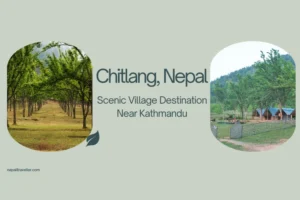Established in 1973 and designated as a UNESCO World Heritage Site in 1984, Chitwan National Park is Nepal’s first and most famous national park. The park covers an area approximately 932 square kilometers (360 square miles), with the Terai lowlands surrounding the foothills of the Himalayas. This large area of protected land spans four districts—Chitwan, Nawalparasi, Parsa and Makwanpur—and has a range of land cover types, consisting of tropical and subtropical forests, riverine grasslands, and the river flood plains of the Rapti, Reu, and Narayani Rivers. The combination of natural resources, rich wildlife, and cultural significance make Chitwan a premier destination for nature lovers and wildlife enthusiasts in South Asia.
Table of Contents
ToggleThe Ecological and Geographical Importance
Chitwan National Park is one of the last remaining Terai ecosystem sites and contains sal forests covering almost 70% of the area and grasslands covering about 20%. Sal forests offer cultural significance locally, and sal leaves are traditionally used as plates in religious festivals. The sal forests and grasslands are bordered by the Churia (Siwalik) Hills that rise up from 150 to 815 meters above sea level and contribute to rich biodiversity.
Two large rivers, the Narayani (also called Gandak) and Rapti, course through the park, forming ox-bow lakes and wetlands, some of which have been designated Ramsar Wetlands that are recognized globally for their ecological significance. These bodies of water support aquatic life, such as gharial and mugger crocodiles, and hundreds of species of birds.
Wildlife of Chitwan: Home to Iconic and Endangered Species
The wildlife at Chitwan National Park is incredibly diverse and fulfills the dream of any wildlife lover. The park is home to 68 species of mammals, over 500 species of birds, 55 species of amphibians and reptiles, and at least 60 species of butterflies: it’s a biodiversity hotspot.
Chitwan is home to some of the most iconic animals:
- Greater One-Horned Rhinoceros (Indian rhinoceros): Chitwan has one of the largest populations of endangered Other Horned Rhino. Worldwide conservation efforts increased their population from a period of near extinction to over 600 individuals. The park regularly trans-locates rhinos into other protected areas to help keep a diverse genetics and stable population, though poaching remains a serious concern.
- Bengal Tiger: Chitwan National Park is recognized for its Bengal tigers, which are the apex predator on the food chain important to the ecological balance of the park. The dense forest and riverine areas provide desirable cover and hunting grounds for striped cats.
- Asian Elephant: Chitwan has both wild and semi domesticated elephants. Used as means of transportation and guides for jungle safaris, the experience of riding on the back of an elephant gives wildlife watchers an added advantage for viewing wildlife.
- Sloth Bear: Chitwan is said to have the highest density of sloth bears in the world. These nocturnal and secretive mammals can be seen roaming through undergrowth every now and then.
- Other Mammals: Chitwans supports many ungulates such as sambar deer, spotted deer (chital), barking deer, hog deer, nilgai or blue bull, and gaur or Indian bison (the largest wild bovine), as well as many smaller carnivores including fishing cats, jungle cats and dholes or wild dogs; and primates such as rhesus macaques and gray langurs.
- Birds: There are over 540 species of birds that have been recorded in Chitwan, making it a fantastic destination for birdwatching. Visitors may see hornbills, peafowl, parakeets, kingfishers, sunbirds, jungle owlets, crested serpent eagles, Bengal pittas, Indian rollers, and many more. The diverse habitats of the park will ensure that visitors will be able to spot resident birds and migratory visitors while the variety of both add colorful sounds and sights to the forest experience.
- Reptiles and Amphibians: Within the rivers throughout the park are gharial crocodiles with long, narrow snouts. There are also pythons, monitor lizards, king cobras, and amphibians in the park’s diverse environments.
Successes and Challenges in Conservation
Chitwan National Park represents a success in conserving wildlife in Nepal and South Asia, distinguishing Chitwan and Nepal from other countries in the region. The limited threats to the one-horned rhinoceros, and the protection and growth of the rhinoceros population, is an example of a success in conservation. At one point, the rhinoceros population was near extinction in the 1960’s. However, with the help of anti-poaching campaigns, habitat management, and anti-poaching and community programs, the rhinoceros population has rebounded.
In addition, Chitwan was one of the first parks to establish a buffer zone around the core area of the park that involved local communities, and buffered the human-wildlife conflicts. The buffer zone encompasses wetlands such as Beeshazar, a Ramsar wetland, which serves an extremely important function for maintaining ecological integrity.
However, there are still challenges, such as poaching where primarily rhinos and tigers were poached for their body parts, habitat loss, the displacement of humans, and limited human-wildlife conflicts. Programme officers from the park have been working in collaboration with local communities and international conservation organizations to mitigate the threats.
Best Times to Visit and What to Expect
Chitwan has a typical tropical monsoon climate. The best seasons to visit are in spring (February–April) and autumn (October–December) when the temperatures are approx. 25 °C, the vegetation is lush, and the skies are filled with migratory birds. The monsoon season, (from mid-June–September), brings heavy rains, flooding, and access to roads may be restricted. The hottest months, March–June, can reach over 43 °C, with strong sunlight, requiring sun protection and wildlife trips are limited to early mornings or late afternoons to avoid the intense heat during the day.
Cultural and Tourism Aspects
Chitwan is not just a biodiversity hotspot, it is also a cultural destination. The indigenous Tharu community has been living in the Terai region of Nepal for millennia and has a strong cultural identity relating to the forest and its wildlife. Historically, including hardship endured from park establishment; the culture and traditional knowledge of the Tharu contribute to eco-tourism and conservation initiatives.
Whether you’re a wildlife enthusiast or traveler, Chitwan offers many activities.
- Jungle Safaris: Elephant-back safaris and jeep safaris are exciting and give park visitors a safe way to experience the park and its wildlife in their natural habitats.
- Bird Watching: with the diversity of bird species, many ornithologists and casual bird watchers flock to the park each year.
- Canoe Rides: Canoeing the Rapti and Narayani rivers is an amazing opportunity for visitors to see aquatic life and birds, including crocodiles and water birds.
- Nature Walks and Tharu cultural experiences: Visitors can learn about the ecological and cultural diversity of the area through nature walks with Naturalist Guides and visits to Tharu villages.
Practical Information for Visitors
Most visitors reach Chitwan National Park via Bharatpur, which is about 10 km away from the park entrance. Bharatpur has an airport with daily flights to and from Kathmandu. There is also road access to various places throughout Nepal, including various major cities.
The best time to visit is during the dry season, which runs from October until March. During this time, wilderness safaris are relatively more frequent, and the weather is mild. The park is hot and humid during the monsoon months of mid-June until September, but it is lush and alive with life.
Why Have Chitwan National Park in Your Travel Plans?
For any wildlife lover, Chitwan National Park is the ultimate jungle experience in the Terai of Nepal. The biodiversity in Chitwan, a rare and endangered one-horned rhinoceros, Bengal tiger, and a remarkable selection of birds and insects, is staggeringly impressive. The national park is also known for its accessibility, the tourism product is managed well, and Chitwan is a fantastic example of a protected area that works well, for the animals and for visitors; it is a welcoming model for protected areas throughout the world.
If you are a naturalist, a bird watcher, a wildlife photographer, or if nature just fascinates you with its raw beauty and mystery, Chitwan is a wonderland! The opportunity to see these magnificent animals up close in their natural habitat, to hear the forest sounds all around you, and knowing that you are supporting a significant cause like conservation is very fulfilling.
Chitwan National Park is not just a reserve for wildlife, it has been part of Nepal’s natural heritage and conservation movement. For wildlife lovers who intend to visit Nepal, Chitwan National Park is an essential stopover. Evergreen memories are created when every safari, boat ride, and trek brings us one step deeper into the amazing tapestry of life that exists in this subtropical jungle paradise.
If you’re a wildlife enthusiast and looking for an amazing place to see the special wildlife in Chitwan, you will never forget the experience and closeness that you have a shared connection with nature’s wonder in Nepal.
Conclusion
Chitwan National Park represents a major milestone in the protection of wildlife and ecology with the riches of the Terai ecosystem it preserves in Nepal. From the one-horned rhinoceros to the Bengal tiger – the diversity of wildlife and multi-faceted bird and reptile life exposes all wildlife enthusiasts to the pleasure of the splendor of nature. The park is successful largely due to strong protection, community involvement, and practices of eco-tourism that have reversed the decline of endangered species and built healthy coexistence between humans and wildlife.
As a UNESCO World Heritage Site and Ramsar Wetland, Chitwan protects not only the rare and endangered species but reflects Nepal’s commitment to the value of natural heritage for future generations. For wildlife enthusiasts in Chitwan, this national park remains an essential, unique, and impressive destination to witness nature and wildlife conservation success stories in action and each visit is supporting conservation initiatives.
Frequently Asked Questions (FAQs)
What type of wildlife can I see at Chitwan National Park?
Chitwan National Park includes over 68 species of mammals including the critically endangered greater one-horned rhinoceros and Bengal Tiger, and sloth bear, and Asian elephant. More than 540 species of birds are present in the park and it includes birds like the rare Bengal florican, and the beautiful peacock and a diverse collection of reptiles including gharial crocodiles and king cobras, and many amphibians, so there is a rich collection of biodiversity for wildlife-lovers!
When is the best time to visit Chitwan National Park?
The best time to visit is the dry season, between October and March. Wildlife sightings are better during the dry season as the weather is generally more pleasant with comfortable temperatures, and dryness encourages wildlife to visit, making sightings easier. The monsoon (June to September) brings spectacular greens and foliage but can limit safari days due to heavy rainfall.
How do visitors interact with the park?
You can participate in a jungle safari via jeep or elephant-back. Bird watchers will be happy visiting here as Chitwan has a plethora of bird species present. You can canoe on the Rapti and Narayani rivers. Guided nature walks are offered, as are cultural tours of the indigenous Tharu villages. There are plenty of activities for any enthusiast to enjoy and immerse themselves in the natural and cultural wealth the Park has to offer.






